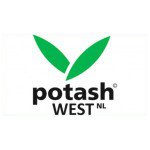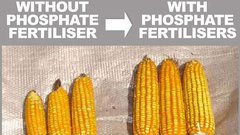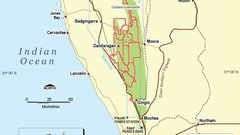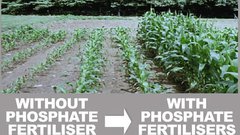Scoping Study demonstrates high potential revenues for PWN’s WA Potash play
Hey! Looks like you have stumbled on the section of our website where we have archived articles from our old business model.
In 2019 the original founding team returned to run Next Investors, we changed our business model to only write about stocks we carefully research and are invested in for the long term.
The below articles were written under our previous business model. We have kept these articles online here for your reference.
Our new mission is to build a high performing ASX micro cap investment portfolio and share our research, analysis and investment strategy with our readers.
Click Here to View Latest Articles
A scoping study for Potash West NL’s (ASX:PWN) Dandaragan Trough potash project in Western Australia shows it could generate over A$200M EBITDA per year over a 20 year mine life.
Margins are strong, with estimated average cash costs at A$40 /tonne of ROM ore, and estimated average revenue is A$91 /tonne.
The Dandaragan Trough holds a globally significant deposit of greensand, made from both rock phosphate and glauconite, a green mineral that contains potash, iron, aluminium and magnesium.
All of these minerals are in high demand as agricultural fertilisers, and PWN’s plan is to both mine and produce products, including potash, to service this global market.
Scoping study combines PWN’s resources
PWN has released previous Scoping Studies for its Dandaragan Trough project, however these considered stand-alone developments for the rock phosphate and glauconite deposits.
The newest scoping study evaluated PWN’s project as a single staged-production project where both materials are extracted by the same operation, utilising PWN’s K-Max production technology.
It projects that a 20 year mine can be established at the Dinner Hill resource, which includes an indicated resource of 120Mt at 2.8% P2O5, 3.1% K2O and 8.2% CaO.
The phosphate deposit at Dinner Hill lies directly above a glauconite resource, and the Scoping Study demonsrates that phosphate can be mined and produced in the first three years of the mine life with a glauconite processing facility set up in the fourth year.
Low margin, high yield operation possible
The scoping study says PWN can have a 4.2Mtpa operation at Dinner Hill with $380M of revenue per year and $168M of operating costs – leaving EBITDA of $212M per year over 20 years, and operating revenue of A$91 a tonne. Estimated average cash costs are A$40 a tonne.
PWN’s Managing Director, Patrick McManus, says putting two resources together offers many advantages. “The Stage 1 Capital requirement is $136M and a significant amount of the Stage 2 Equity financing could be funded from operating cashflows,” he says.
“It is important to note that the resources underpinning this model are based on 10km2 of the Dinner Hill project area. Within the 60 km2 of Dinner Hill an exploration target between 1 and 1.5 billion tonnes has been reported. The optionality to increase the scale of the operation is very valuable”.
PWN investments could open more revenue streams
PWN has also recently invested in two companies operating within the potash sector.
The first is a German firm called East Exploration, of which PWN is earning a 55% interest. EE has been granted two exploration licenses for a 450km2 potash field in Central Germany called the South Harz project.
East Exploration has just released an exploration target for the project of 5,441MMT (million metric tonnes) of mineralised rock, of which up to 1,285MMT is thought to be potash.
The second investment PWN has made is a 25% interest in a company that holds the license for a unique lithium carbonate producing technology, based on the K-Max process PWN has developed for its greensand operations.
PWN’s technology partners Strategic Metallurgy have been helping develop the K-Max process while also creating new methods, including making battery grade lithium from mica rocks.
Strategic Metallurgy have agreed to invest 25% of this application of the K-Max technology and a licensing agreement to use it has been struck with a company named Cobre Montana, which could soon be using the process and paying dues to PWN.
The company says it will now pursue shareholder approval to license the K-Max process.
General Information Only
S3 Consortium Pty Ltd (S3, ‘we’, ‘us’, ‘our’) (CAR No. 433913) is a corporate authorised representative of LeMessurier Securities Pty Ltd (AFSL No. 296877). The information contained in this article is general information and is for informational purposes only. Any advice is general advice only. Any advice contained in this article does not constitute personal advice and S3 has not taken into consideration your personal objectives, financial situation or needs. Please seek your own independent professional advice before making any financial investment decision. Those persons acting upon information contained in this article do so entirely at their own risk.
Conflicts of Interest Notice
S3 and its associated entities may hold investments in companies featured in its articles, including through being paid in the securities of the companies we provide commentary on. We disclose the securities held in relation to a particular company that we provide commentary on. Refer to our Disclosure Policy for information on our self-imposed trading blackouts, hold conditions and de-risking (sell conditions) which seek to mitigate against any potential conflicts of interest.
Publication Notice and Disclaimer
The information contained in this article is current as at the publication date. At the time of publishing, the information contained in this article is based on sources which are available in the public domain that we consider to be reliable, and our own analysis of those sources. The views of the author may not reflect the views of the AFSL holder. Any decision by you to purchase securities in the companies featured in this article should be done so after you have sought your own independent professional advice regarding this information and made your own inquiries as to the validity of any information in this article.
Any forward-looking statements contained in this article are not guarantees or predictions of future performance, and involve known and unknown risks, uncertainties and other factors, many of which are beyond our control, and which may cause actual results or performance of companies featured to differ materially from those expressed in the statements contained in this article. S3 cannot and does not give any assurance that the results or performance expressed or implied by any forward-looking statements contained in this article will actually occur and readers are cautioned not to put undue reliance on forward-looking statements.
This article may include references to our past investing performance. Past performance is not a reliable indicator of our future investing performance.





